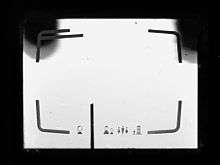Lomo LC-A
The LOMO LC-A (Lomo Kompakt Automat) is a fixed lens, 35 mm film, leaf shutter, zone focus, compact camera introduced in 1984. Its design is based on the Cosina CX-2, with the difference being that it lacks a swiveling front and self-timer[1]. It was built in Soviet-era Leningrad by Leningrad Optics and Mechanics Association (LOMO).[2]
 LOMO LC-A camera | |
| Overview | |
|---|---|
| Type | Compact, point and shoot |
| Lens | |
| Lens | Fixed, Minitar 1 32mm f/2.8 |
| Sensor/medium | |
| Film format | 35mm (135) |
| Film size | 36mm x 24mm |
| ASA/ISO range | 25-400 |
| Film advance | Manual |
| Film rewind | Manual |
| Focusing | |
| Focus modes | Manual, zone focus (0.8m, 1.5m, 3m, ) |
| Exposure/metering | |
| Exposure modes | Programmed auto, manual with fixed shutter speed |
| Exposure metering | Cadmium Sulphide (CdS light meter |
| Flash | |
| Flash | Hot shoe only |
| Flash synchronization | 1/60s; rear sync. only |
| Shutter | |
| Shutter | Electronically controlled |
| Shutter speed range | 2m to 1/500s |
| General | |
| Battery | Three S76 |
| Dimensions | 107 x 68 x 43.5 mm |
| Weight | 250g |
| Released | 1984 |
Production of the camera ceased in 1994.[3] In the mid-1990s, a group of enthusiasts from Vienna persuaded LOMO to restart production,[2] which continued until 2005.
The LOMO LC-A's replacement, the LC-A+, was introduced in 2006 and production moved to China.[4] The LC-A+ featured the original LC-A lens manufactured by LOMO in Russia. This changed in 2007 and lenses on subsequent models have been made in China.[3] Some LC-As were sold badged as Zenith,[5] this label was only a sticker underneath the lens. Zenit (Zenith in some countries) is a trademark of KMZ (Krasnogorsk Mechanical Works).
Operation
The only automatic function offered by the LC-A is exposure. Film loading, winding, rewinding, and focus adjustments are accomplished manually. Aperture can also be set manually, the shutter speed being fixed at 1⁄60 s (this ability was removed from the LC-A+).
Exposure is completely automatic when the camera is set to "A"; the shutter speeds range from 2 minutes to 1⁄500 s. The aperture range is f/2.8 to f/16. The automatic exposure system compensates for changes in light levels after the shutter is opened by increasing or decreasing the shutter speed. This, in conjunction with the rear-curtain flash-sync, results in interesting effects with flash photography in low ambient light levels.
The lens is focused by selecting one of four zones (0.8 m, 1.5 m, 3 m or ∞). Older versions of the camera feature viewfinder icons showing the currently selected focus zone, a feature omitted from later models.
A battery checking feature uses a LED inside the viewfinder; if there is sufficient power this illuminates whenever the shutter release button is lightly depressed. Another viewfinder LED illuminates whenever the camera's chosen shutter speed is below 1⁄30 s.

Body design
The size and shape is very close to that of the Cosina CX-2, the main difference being that the lens bezel is fixed (unlike the rotating one of the CX-2). Power is supplied by three 1.5v silver oxide cells (S76, LR44).
See also
- Lomography
- Cosina
- Minox, especially Minox 35 mm compact cameras
- Olympus XA
References
- "The Lomo LC-A's Father - The Cosina CX-2". 8 August 2011. Retrieved 2020-03-15 – via www.lomography.com.
- Dowling, Stephen (22 November 2012). "Did the Lomo camera save film photography?". BBC News. Retrieved 2018-05-10 – via www.bbc.co.uk.
- "Lomo LC-A+ 35mm Camera - Microsite - Lomography". Lomo LC-A+ 35mm Camera - Microsite - Lomography. Retrieved 2018-05-10.
- "Lomos: New take on an old classic". BBC News. 22 September 2007. Retrieved 2018-05-10 – via news.bbc.co.uk.
- "LOMO LC-A - Camera-wiki.org - The free camera encyclopedia". camera-wiki.org.
External links
| Wikimedia Commons has media related to Lomography. |
| Wikimedia Commons has media related to LOMO LC-A. |